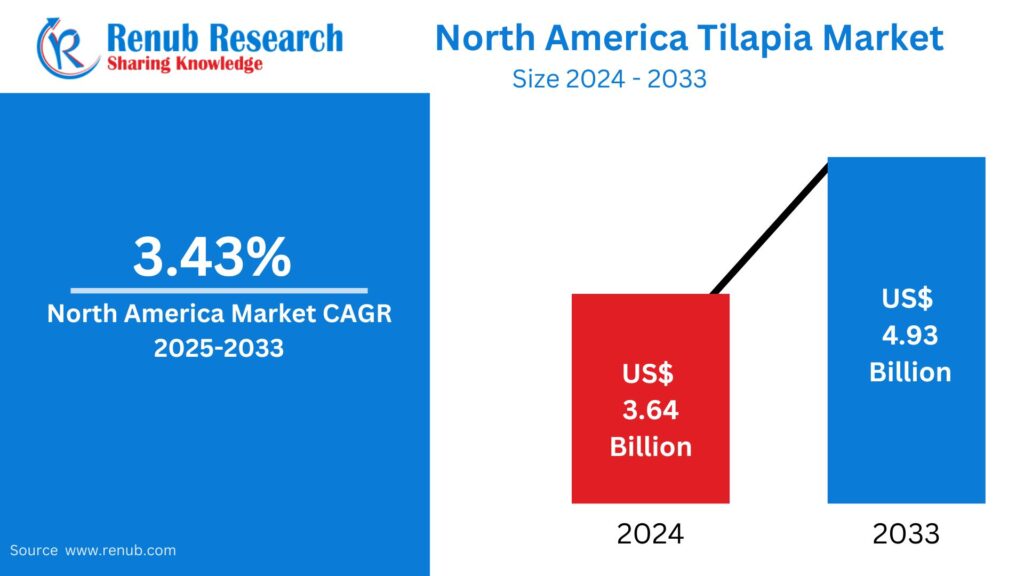North America Tilapia Market Size and Share Analysis – Growth Trends and Forecast Report 2025–2033
Description
The North America Tilapia Market is poised for robust growth, projected to rise from US$ 3.64 billion in 2024 to US$ 4.93 billion by 2033, registering a CAGR of 3.43% during the forecast period. The market is witnessing strong momentum due to shifting consumer preferences toward healthy, sustainable, and affordable protein sources. Key factors fueling this growth include advancements in aquaculture technology, rising health awareness, increasing demand for eco-certified seafood, and evolving culinary trends driven by multicultural influences.
Table of Contents
- Introduction
- Market Overview
- Growth Drivers
- Market Challenges
- Country-Level Analysis
- Market Segmentation
- Competitive Landscape
- Recent Developments
- Forecast Outlook (2025–2033)
- Conclusion
- Get Free Sample
North America Tilapia Market Trends & Summary
Tilapia has emerged as one of the most consumed fish species in North America, prized for its mild taste, affordability, nutritional value, and versatility in various cuisines. As consumers increasingly prioritize lean protein sources that align with environmental and ethical standards, tilapia has become a natural choice for both everyday meals and restaurant menus. With supply chains becoming more efficient and aquaculture systems integrating technology such as IoT, RAS (Recirculating Aquaculture Systems), and Biofloc, the industry is experiencing a transformation toward sustainable, high-efficiency production.
North America Tilapia Industry Overview
Tilapia is a cornerstone of modern aquaculture due to its resilience, rapid growth rate, and low feed conversion ratio, making it both an economic and ecological choice for producers. As North American consumers increasingly shift toward low-fat, protein-rich diets, tilapia stands out with low calories and high nutrient density—containing vitamin B12, selenium, and omega-3 fatty acids. The rise of flexitarian diets, coupled with concerns over mercury levels in traditional seafood, is further fueling tilapia’s market adoption.
Governmental and institutional support for sustainable aquaculture practices, such as those promoted by the Aquaculture Stewardship Council (ASC) and other bodies, has led to more traceable, responsible sourcing—a trend that resonates with increasingly conscious North American consumers.
Growth Drivers for the North America Tilapia Market
- Rising Demand for Affordable Protein
As meat prices fluctuate and health awareness rises, tilapia’s positioning as a low-cost yet nutritious alternative becomes increasingly relevant. Whether as an ingredient in fast-casual dining or home-cooked meals, tilapia appeals to budget-conscious households, school lunch programs, and meal kit providers. Its cost-efficiency and versatility are making it an everyday staple.
- Technological Advancements in Aquaculture
Modern tilapia farming is increasingly adopting smart farming techniques:
- IoT sensors for monitoring water quality.
- Machine learning for feeding efficiency.
- Biofloc systems for nutrient recycling.
- Genetically improved strains for higher disease resistance and productivity.
These advancements reduce dependency on wild fish meal and improve the sustainability profile of the product, attracting eco-conscious buyers and reducing operational costs.
- Sustainability and Ethical Sourcing
Consumer preference is rapidly tilting toward traceable seafood. Certifications from ASC and Best Aquaculture Practices (BAP) offer confidence in product sourcing. Sustainability-conscious millennials and Gen Z consumers are willing to pay more for verified sustainable seafood, boosting demand for certified tilapia.
- Diverse Culinary Integration
The mild flavor of tilapia makes it easily adaptable across ethnic cuisines—from Mexican tacos and Chinese steamed dishes to Caribbean escovitch. This adaptability is crucial in North America’s multicultural food landscape, and food service providers are actively leveraging tilapia in multi-ethnic offerings.
Challenges in the North America Tilapia Market
- Price Sensitivity and Cost Volatility
Although tilapia is viewed as a budget protein, cost fluctuations in transportation, fish feed, and logistics can impact pricing and margins. Even marginal price increases can shift demand toward cheaper protein sources such as frozen chicken or canned tuna.
- Import Dependency and Supply Chain Risk
A significant portion of North America’s tilapia supply comes from imports—especially China, Honduras, Ecuador, and Indonesia. This reliance poses vulnerabilities to:
- Geopolitical instability
- Pandemics (e.g., COVID-19)
- Logistical disruptions
These interruptions can result in delayed deliveries, product shortages, and increased prices, affecting both B2B and B2C segments.
Country-Wise Insights
United States Tilapia Market
The U.S. dominates the North American tilapia market, driven by:
- A growing health-conscious population
- Strong demand in retail chains and foodservice sectors
- Rising influence of meal kit services
Noteworthy Development:
In 2023, Superior Fresh Seafoods acquired Tilapia Mexico, strengthening supply chain resilience and expanding its production footprint.
Canada Tilapia Market
Canada is witnessing steady growth, fueled by:
- A multicultural population that values fish in daily cuisine.
- Growing retail availability of frozen fillets and fresh tilapia.
- Increased adoption of sustainable aquaculture practices in provinces like British Columbia and Quebec.
Mexico Tilapia Market
Mexico plays a dual role—as a major producer and consumer:
- Tilapia is ingrained in local dishes and is economically vital to rural aquaculture communities.
- Despite strong domestic production, import volumes remain high due to strong demand and low prices from Asian suppliers.
Challenges include:
- Need for stronger regulatory frameworks
- Price instability due to feed and import fluctuations
North America Tilapia Market Segmentation
By Species
- Nile Tilapia (dominant)
- Tilapias Nie
- Others
By Product
- Frozen Whole Tilapia
- Fresh Fillet Tilapia
- Frozen Fillet Tilapia
By Country
- United States
- Canada
- Mexico
- Rest of North America
Competitive Landscape
Leading Companies Covered
Each profiled company includes: Overview, Key Persons, Recent Development, and Financial Insights.
- High Liner Foods Inc.
- Mowi ASA
- NH Foods Ltd
- Beaver Street Fisheries
- Cooke Inc
- FCF Co. Ltd.
- Pacific American Fish Company Inc.
- Regal Springs
These companies are focusing on vertical integration, aquaculture innovation, and eco-labelling certifications to maintain competitive advantages in a dynamic market.
New Publish Report:
Conclusion
The North America Tilapia Market is set for steady growth through 2033, driven by technological innovation, rising demand for affordable protein, and increased consumer focus on sustainability. As challenges such as import reliance and price volatility persist, strategic investment in domestic aquaculture infrastructure and digital logistics could reshape the competitive landscape. Companies that align with ethical sourcing, product traceability, and nutritional transparency are best positioned to capitalize on emerging consumer trends.
- North America Tilapia Market
- North America Tilapia Market
- North America Tilapia Market
Related posts:
 Types of Digital Printing Services Available in Dubai dfgrfgt
Types of Digital Printing Services Available in Dubai dfgrfgt
 Choosing the Best iPhone 15 Pro Cover for Ultimate Protection
Choosing the Best iPhone 15 Pro Cover for Ultimate Protection
 Business Consulting Solutions That Help Scale Your Business Quickly
Business Consulting Solutions That Help Scale Your Business Quickly
 The Importance of UX and UI Testing for Exceptional Digital Experiences
The Importance of UX and UI Testing for Exceptional Digital Experiences
 Why Bakers Are Switching to Sponge Cake Premix for Consistent Results
Why Bakers Are Switching to Sponge Cake Premix for Consistent Results
 Is Your Burlington Home Properly Covered? Understanding Policy Gaps Before It’s Too Late
Is Your Burlington Home Properly Covered? Understanding Policy Gaps Before It’s Too Late
 Expert Chain Link Fence Installation Kingston – What You Need to Know
Expert Chain Link Fence Installation Kingston – What You Need to Know
 The Rise of the Pull Stussy: A Streetwear Essential pull stussy
The Rise of the Pull Stussy: A Streetwear Essential pull stussy








